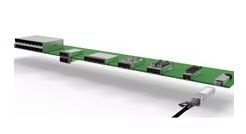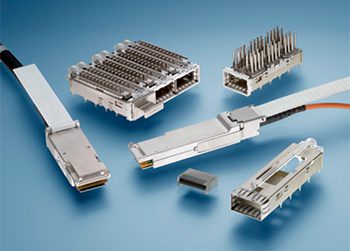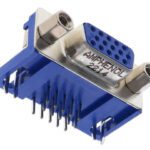What are SFP (Small form factor pluggables)?
Meet the Connector: SFP (Small form-factor pluggable)
An SFP (small form-factor pluggable) is a hot-pluggable transceiver that allows devices to communicate with one another through data transmission. SFPs provide the required optical or electrical reach via copper or fiber optic cables. SFPs transmit and receive data at the same time, eliminating the need for additional equipment to perform those processes separately. They are mainly used in computer networks to facilitate high-speed internet connections.
The transceiver connects to the device via a specially designed SFP port. Typically, the right port is the receiver and the left port is the transmitter. An audible click ensures that the transceiver is connected and ready for use.
The original versions of this hardware were called gigabit interface converters (GBICs). While they worked the same, they were significantly larger than today’s SFPs, which are subsequently also known as mini-GBICs. Along with the smaller size, functionality has also improved allowing greater bandwidth and decreasing power consumption. Bob Hult, director of product technology at Bishop & Associates Inc., explained in his article, Pluggable Optical Transceivers Continue to Evolve, that the first generation of SFP specification, SFF INF-8074i (released in 2001) defined a 100 Mb/s pluggable device. “Design flexibility as well as future upgradeability made the SFP an instant hit,” he wrote.

Amphenol’s SFP product family supports applications for up to 6 Gb/s per channel. The connector accepts multiple transceivers per INF-8074i and combines, transmits, and receives functions in a low-cost, compact format. The assemblies are designed to maximize valuable space on the PCB. The cages have a two-piece construction with enhanced transceiver mating tabs available in a press-fit version or a solder tail version. Light pipes are designed to deliver a “link” or “no link” status using LEDs attached on the PCB.
The small size of the SFPs makes them popular for use where space is limited. They can be plugged in and removed while the device is running (hot swappable), which is useful for expanding networks without having to redesign the cable infrastructure. Because SFP transceivers work with copper and fiber optics, they are compatible with various connection options, as well as communication standards including Ethernet, fiber, and SONET (synchronous optical networking).

Supporting 2.5 to 10 Gb/s data rates for Gigabit Ethernet and Fibre Channel applications, Molex’s SFP+ and SFP products ensure industry-wide compatibility.
Design Notes
Specifying the correct type of SFP depends on the distance between devices, the network, the wavelength, and module. The most common network type is 1G, used for short distance (100 m to 550 m) and longer distances (10 km to 80 km). WDM (wavelength-division multiplexing) is used for distances of 80 km to 200 km.
Some common SFP types
For 1G shorter distance (100-550 m): 1000BASE-T SFP and 1000BASE-SX SFP (SX stands for short range). The 1000BASE-T SFP has an RJ45 interface and supports a network distance up to 100 m. The 1000BASE-SX is a multimode SFP that works on 850 nm wavelength and can reach up to 550 m.
For 1G longer distance: 1000BASE-LX SFP supports a 10 km network distance over single-mode duplex LC cables on a 1310 nm wavelength. 1000BASE-EX (1310 nm) and 1000BASE-ZX (1550 nm) support 40 km and 80 km distance, respectively.
WDM technology allows for increased network capacity at lower cost. CWDM SFP comes in 18 wavelengths from 1270 nm to 1610 nm and supports a distance up to 80 km. DWDM SFP supports distances of 80 km and 200 km.
The QSFP (quad small form-factor pluggable) arrived in 2006, bringing support for higher port density applications. The original QSFP was a full duplex optical and copper solution featuring four 1 Gb independent transmit and receive channels which can replace up to four single channel SFP connectors. QSFP+ increased the speed to 10 Gb per channel bringing the aggregate bi-directional bandwidth to 40 Gb/s. The transceiver module accepts fiber cables which are terminated with LC or 12 fiber MPO connectors. This increased capacity requires a 30% increase in size compared to the standard SFP.

The Quad Small Form-factor Pluggable (QSFP) product line from TE Connectivity is a four-channel package, offering three times the density of traditional SFP ports and now supports speeds up to more than 25 Gb/s per channel for the new 100 Gb/s Ethernet and 100 Gb/s InfiniBand Enhanced Data Rate applications.
OSFP (octal small form factor pluggable) targets 800 Gb applications and features integrated open or closed top heat sink fins and ventilation holes. Modules are designed to manage up to 15 watts per port. OSFP connectors are slightly wider and deeper than the QSFP profile. Up to 32 OSFP ports can be mounted on a line card compared in the same space as 36 QSFP-DD modules. OSFP optic modules consume up to 15 watts, as opposed to 12 watts for QSFP-DD.
Cable types
Twisted pair or twinaxial copper or multi-mode or single-mode fiber
Standardization
The SFP transceiver is not standardized by any official standards body, but it is specified by the Small Form Factor Technology Affiliate Technical Working Group (SNIA FF), a multi-source agreement (MSA) by competing manufacturers.
Markets & Applications
SFPs are used in datacom and telecom. They are found in Ethernet switches, routers, firewalls, network interface cards, Fibre Channel over Ethernet (FBoE), and storage equipment.
Suppliers Amphenol Communications Solutions, Molex, Phoenix Contact, Samtec Inc., TE Connectivity
Related Products
- OSFP transceivers
- QSFP+/QSFP DD
- SFP
Like this article? Check out our other Meet the Connector and Networking articles, our Datacom/Telecom Market Page, and our 2023 Article Archive.
Subscribe to our weekly e-newsletters, follow us on LinkedIn, Twitter, and Facebook, and check out our eBook archives for more applicable, expert-informed connectivity content.
- Sealing Success: Overmolding for More Secure Connections - April 23, 2024
- Medical Cable Assemblies Product Roundup - April 23, 2024
- Mezzanine Connectors Product Roundup - April 16, 2024





